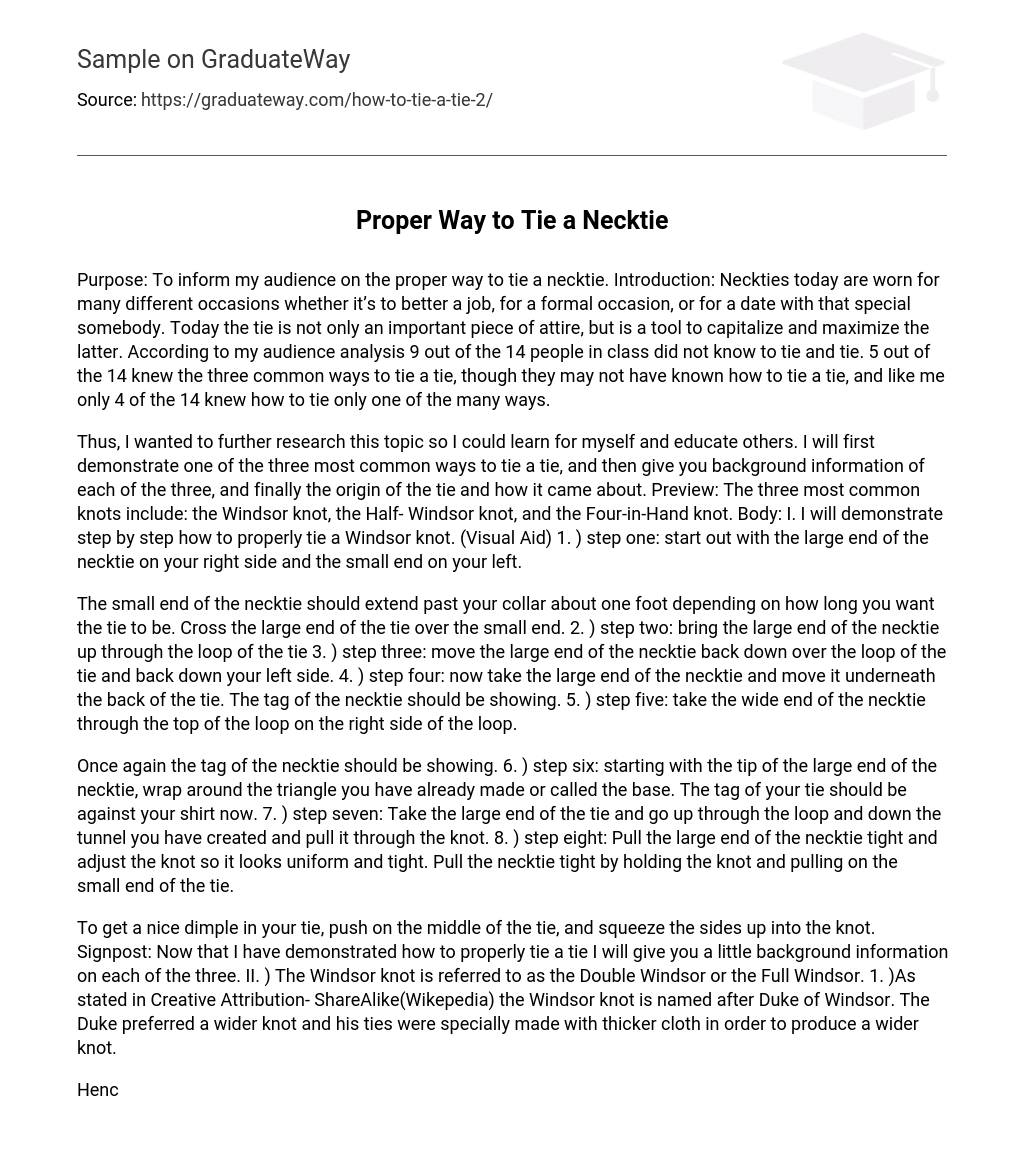The purpose of this text is to inform my audience about the proper way to tie a necktie. Neckties are worn for various occasions such as job interviews, formal events, and dates. Nowadays, a tie serves not only as a piece of clothing but also as a means to enhance one’s appearance.
Based on my audience analysis, it was found that out of the 14 individuals in the class, 9 did not know how to tie a tie at all. Additionally, 5 knew about the three common methods of tying a tie but were unfamiliar with the actual steps involved. Similarly, like myself, only 4 out of the 14 knew how to tie a tie using just one of the many techniques available.
My purpose was to further study this topic in order to acquire knowledge for myself and educate others. I will initiate by showcasing one of the three main techniques for tying a tie, while also providing background information on each technique and exploring the origins of the tie. The three most popular knots are the Windsor knot, the Half-Windsor knot, and the Four-in-Hand knot. In my presentation, my primary focus will be on presenting step-by-step instructions for correctly tying a Windsor knot, utilizing visual aids as assistance. To commence, ensure that the large end of the necktie is positioned on your right side and the small end is placed on your left.
Extend the small end of the necktie past your collar by about one foot to achieve the desired tie length. Cross the large end over the small end and bring it up through the loop. Then, move it back down over the loop and down your left side. Next, place the large end underneath the back of the tie, ensuring that the tag is showing. Lastly, pass the wide end through the top of the loop on your right side.
Once again, the necktie tag should be visible. Step six: Begin by wrapping the tip of the large end of the necktie around the previously formed triangle, also known as the base. The tag of the tie should now be against your shirt. Step seven: Take the large end of the tie and pass it up through the loop, then down through the tunnel you have created, and finally pull it through the knot. Step eight: Tighten the knot by pulling the large end of the necktie and adjust it to ensure it appears even and secure. Hold on to the knot and pull on the small end of the tie to tighten it further.
To create a fashionable dimple in your tie, exert force on the middle of the tie while elevating the sides towards the knot. Signpost: Following instructions on tying a tie properly, I will now offer some context about the three types. II.) The Windsor knot, also referred to as the Double Windsor or the Full Windsor, received its name from the Duke of Windsor. 1.) As per Creative Attribution-ShareAlike (Wikipedia), the Duke preferred a wider knot and his ties were specifically tailored with thicker material to achieve a broader knot.
The Windsor knot was created to imitate the wide knot of regular ties. When tied correctly, this knot is secure and does not loosen. It offers comfort, symmetry, and balance. The large size of the knot is beneficial for showcasing patterns when wearing a closed coat or jacket and provides warmth in colder months. Alternatively, the Half Windsor knot is similar to the Windsor but less bulky and easier to tie. This triangular knot complements lightweight fabrics and can be worn with an open collar or shirt (Necktie). It suits any occasion. Lastly, the Four-in-Hand knot is a simple way to tie a necktie that gives off a professional appearance when done correctly. This less intricate knot only requires a couple of wraps and resembles knots used in zipper ties and clip-on ties. With our discussion on each of these knots complete, let’s now explore the origin and history of ties.
The origin of the tie can be traced back to 210 B.C., as referenced in Necktie. Shih Huang Ti, China’s first emperor, had a fear of death and devised an extreme solution to keep him accompanied in the afterlife: he ordered the massacre of an entire army. Nevertheless, his advisers persuaded him to opt for life-size replicas instead. Despite their variations, all the replicas shared one common feature – the neck cloth. It remains perplexing why the Chinese adorned themselves with these silk cloths considering historical accounts indicate that they did not wear neck ties.
One theory suggests that the use of silk in neckties originated from the idea that it was a symbol of luxury. It is believed that by wearing a silk tie, the emperor would be bestowing the highest honor upon his soldiers. This is how the tradition of wearing neckties began. Wearing a tie not only adds style but also gives a professional appearance. As Oscar Wilde once said, tying a necktie is the first step towards a serious life. Despite their simplicity, neckties play a crucial role in shaping people’s perception of you. I hope you have learned how to tie a tie and gained some interesting facts about them that you can use when planning your outfit for any occasion.





